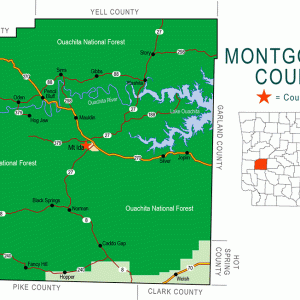calsfoundation@cals.org
Mauldin (Montgomery County)
The former town of Mauldin, in Montgomery County, is located between Pencil Bluff (Montgomery County) and the county seat, Mount Ida. Fueled by the logging industry, Mauldin was once the largest town in the county, although twenty-first-century Mauldin is a ghost town, with little physical evidence remaining.
The Caddo River Lumber Company established Mauldin around 1922 where company logging railroads in Montgomery County crossed land purchased from William Mauldin, a local homesteader. The easily accessible landscape and proximity to vast reserves of timber in the northern portion of the county created an ideal location for a logging town. Timber was easily transported by rail to the large mills at Glenwood (Pike County) or Rosboro (Pike County).
There, on William Mauldin’s land, the company constructed a mill, a school, a church, a company office, a post office, a doctor’s office, homes, and other buildings. They also dammed two streams to supply water for the boilers, constructed a repair shop for engines and cars of log trains, and created two large ponds for floating logs. During the early 1920s, the Caddo River Lumber Company rapidly purchased large tracts of local property, paying an average of $500 per forty acres of timbered land. Using crosscut saws, loggers felled the virgin hardwood, which was then taken to Mauldin by mule teams or by trains running on railroad spur lines. The company’s hardwood mill operated twenty-four hours a day, with workers taking ten-hour shifts.
Mauldin continued to boom, and 896 people lived in the town by the 1930 census. By comparison, the same census recorded the population of the county seat, Mount Ida, as 512. The local grade school, supported by the lumber company, served 229 children in 1926. Youth who wished to attend high school could ride a bus into Mount Ida; however, most quit school after the eighth grade. The school closed in 1937.
Mauldin’s church stood beside the school and hosted Baptist, Methodist, and Presbyterian pastors on rotating Sundays. The company-owned store, or “commissary” as locals called it, served as both a social center and a commercial center, providing a place for people to congregate and shop. Townspeople could purchase a variety of goods at the commissary, such as candy, tobacco, meat, hardware, and clothing items. Because few people owned vehicles, the store also offered a delivery service for ice.
One local doctor, who was a company employee, served the entire town. Almost no one in Mauldin had an indoor toilet, and outdoor privies in such close proximity to homes meant that typhoid was frequently a health concern. Pellagra, a lack of niacin caused by poor diet, affected many Mauldin residents, who often found it difficult to obtain fresh and healthy food. The mill workers and loggers also faced a constant threat of injury on the job, although only one logging accident death is recorded. The Caddo River Lumber Company deducted all medical expenses from employee wages.
By the mid-1930s, most of the virgin timber had been harvested from Montgomery County. The Caddo River Lumber Company sold all of its land holdings to the U.S. Forest Service (USFS), allowing for the expansion of the Ouachita National Forest. In the twenty-first century, two ponds and a few block foundations are the only remaining physical evidence of Mauldin. The USFS has created an interpretive walking trail providing visitors with historical and ecological information on the Mauldin area.
For additional information:
Montgomery County Historical Society. Montgomery County, Our Heritage. 2 vols. Mount Ida, AR: Montgomery County Historical Society, 1987, 1990.
Smith, Kenneth L. Sawmill: The Story of Cutting the Last Great Virgin Forest East of the Rockies. Fayetteville: University of Arkansas Press, 1986.
Hattie Felton
Historic Arkansas Museum
 Montgomery County Map
Montgomery County Map 




Comments
No comments on this entry yet.